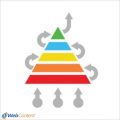How to Improve Your Rankings Using the SEO Pyramid Strategy

When most people think of search engine optimization, they consider all elements on a level playing field. However, there are components of your online marketing strategy that are worth more than others, making it important to know which areas you should focus on for the best results. The SEO pyramid is the best way to prioritize your search engine optimization efforts to maximize its potential.
Level One
Your index page, otherwise known as your homepage, is at the bottom of the SEO pyramid. While it’s important to make sure you know how to choose keywords for this page, along with the others, it will always be much more difficult to get your homepage to rank. In fact, many businesses never achieve good search engine rankings for their homepage. For this reason, it’s best to place your homepage as a lower priority on the totem pole of your online marketing strategy. Don’t neglect it altogether, but don’t allow it to consume your time or that of your content marketing service.
Level Two
The next level involves secondary pages on your website. These pages should use your top priority keywords to give you a solid foundation on which you can build your search engine rankings. These won’t necessarily be high traffic pages, but they are more important than your homepage. In addition to implementing the appropriate keywords on each page, it’s important to link to other related pages. Internal linking should be the backbone of your online marketing strategy. Remember, these pages will define the themes of your site, as well as the keywords you are focusing on. They may not rank well, but they will make a difference in your overall SEO.
Level Three
This level consists of doorway pages designed to draw your readers from your basic pages to more in-depth content. These pages are the ones you should add to your homepage as links to guide your visitors naturally through your website. These pages typically rank for one or two keyword phrases, though they are also difficult to rank well for. This is due to the competitive nature of the keywords often used for pages on this level.
Level Four
Content on this level is similar to the pages found on level three, but they go more in-depth and provide valuable information your readers are looking for. At this level, you will use more keywords than you did on the other levels, expanding out and attempting to rank better for less competitive keywords. This is also an important place for linking. You can link one level up or one level down to relevant content that will keep your readers on your website for longer. However, at this point in the pyramid, you may also want to link to other industry-relevant websites that relate to the topic at hand. This will give your website greater credibility and further enhance your search engine optimization.
Level Five
Not all websites will require a level five for site content. However, these pages are often considered the money makers because of the large amount of traffic they typically generate. This content should contain the information your readers are most likely looking for, answering their questions. Make sure every page or blog post on this level is linked to other relevant pages at or near the same level. This will keep readers moving through your website, increasing the chances they will make a final purchase from your business.
The various types of content in your online marketing strategy will fall at different spots in the SEO pyramid. While your site content is likely to exist in the lower levels, blog posts and landing pages are more likely to require more of your focus because of their importance in SEO. As long as you know how to choose keywords and then effectively implement them into your content, you will see an improvement in your rankings over time.
If you’re looking for help with an effective online marketing strategy, contact us. We can help you navigate the SEO pyramid and improve your rankings to drive more traffic.



